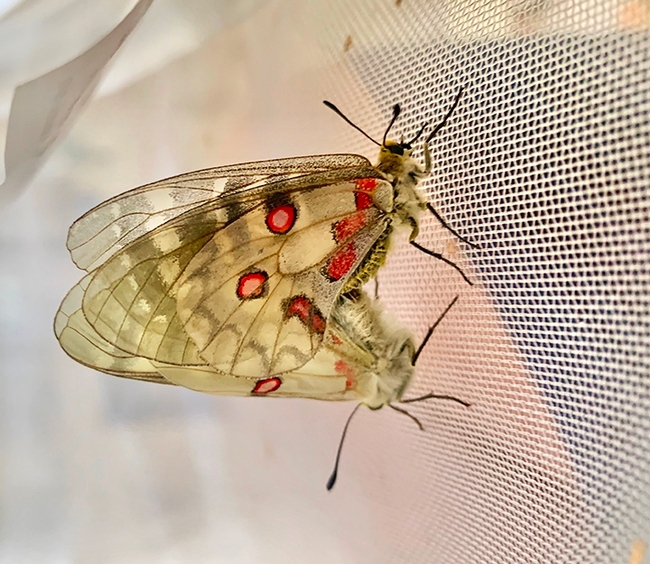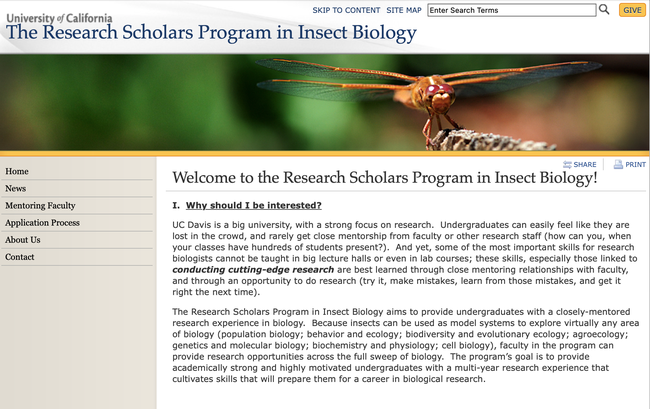
A warm welcome!
"UC Davis is a big university, with a strong focus on research," the text begins. "Undergraduates can easily feel like they are lost in the crowd, and rarely get close mentorship from faculty or other research staff (how can you, when your classes have hundreds of students present?). And yet, some of the most important skills for research biologists cannot be taught in big lecture halls or even in lab courses; these skills, especially those linked to conducting cutting-edge research are best learned through close mentoring relationships with faculty, and through an opportunity to do research (try it, make mistakes, learn from those mistakes, and get it right the next time)."
The program, co-founded and co-directed by three faculty members of the UC Davis Department of Entomology and Nematology--distinguished professor Jay Rosenheim and professors Joanna Chiu and Louie Yang--"aims to provide undergraduates with a closely-mentored research experience in biology. Because insects can be used as model systems to explore virtually any area of biology (population biology; behavior and ecology; biodiversity and evolutionary ecology; agroecology; genetics and molecular biology; biochemistry and physiology; cell biology), faculty in the program can provide research opportunities across the full sweep of biology. The program's goal is to provide academically strong and highly motivated undergraduates with a multi-year research experience that cultivates skills that will prepare them for a career in biological research."
From the depths of this innovative and excellent program, launched in 2011, come outstanding scholars--scholars like Gwen Erdosh and Gary Ge, the first two recipients of the Dr. Stephen Garczynski Undergraduate Research Scholarship. This award, sponsored by the Pacific Branch, Entomological Society of America, memorializes Stephen Garczynski (1960-2019), a research geneticist at the USDA Agricultural Research Service in Wapato, Wash.,"who had an unmatched passion for mentoring undergraduate students in their research," according to the PBESA website.
Erdosh, a research scholar in the Yang lab, won the inaugural scholarship, presented in 2022. She's continuing her research, and as @gwentomologist, is sharing her knowledge of entomology with her 77,000 followers on Instagram.
This year Ge won the undergraduate scholarship. He studies with Yang and UC Davis Distinguished Professor Art Shapiro of the Department of Evolution and Ecology, and researches the American Apollo butterfly (Parnassius clodius) as a model to study how microclimatic conditions affect cold-adapted insects. Ge is a research assistant with Shapiro's Central California Butterfly Population and Diversity Trends Study, and works with Yang as a project manager and a research assistant on his Milkweed phenology study.

Ge will be honored at the annual PBESA meeting, April 2-5 in Seattle, which encompasses 11 Western states, plus Canada, Mexico and U.S. territories. He will receive a $1000 award for travel expenses and a waived registration fee.
Ge just finished writing a National Science Foundation's Graduate Research Fellowship Program (GRFP) grant proposal. The results are expected to be announced in April.
His hypothesis: "that mid-elevation populations of P. clodius have the best cold tolerance as overwintering eggs. The main factor behind this is snow cover. Snow cover is known to provide significant insulation to whatever is underneath, usually creating higher microclimatic temperatures under the snow than above. At mid-elevations, the winter temperatures are lower than at low elevations, and the snow cover is supposedly less and more unstable compared to higher elevations. This means the mid-elevation populations are likely exposed to the coldest winter temperature, and have locally adapted to it.”
Ge said he is testing his hypothesis “partly by looking at the supercooling points (SCPs) of diapausing eggs in different populations. The SCP indicates the freezing temperature of the egg, so it should be close to the lower lethal temperature. So, the population with the lowest average SCP would be the most cold-tolerant. I got some preliminary results recently indicating the SCP of the mid-elevation eggs is around -30 °C, which is pretty cold! On the side I am also testing the egg SCP of a Parnassius behrii population. This is a California endemic. It would be cool to see how their thermal tolerance differ from that of P. clodius as P. behrii is only found in high-elevation habitats (mostly around and above 9,000 feet).”
“The genus Parnassius is prone to global warming due to its affinity for alpine and arctic habitats, and several species are considered to be threatened," Ge said.
Shapiro, who has monitored butterfly populations across central California for the last 50 years, says that “Parnassians are a group of cold-adapted Northern Hemisphere butterflies that are becoming increasingly important as objects of physiological, ecological and evolutionary study. They are only likely to grow more important in the context of climate change. Thus, Gary's study is very timely and should attract plenty of attention! It is demanding given the rigorous conditions in which they breed and develop, and he is likely to learn a lot that will facilitate future lab and field studies.” On his research website, Art's Shapiro's Butterfly site, Shapiro describes P. clodius in detail.
Gary, born in Beijing, China, attended elementary school in New York City, middle school in Singapore, and high school in Hawaii, and now California for college. “This allowed me to have experience with a range of lepidopterans and ants and termites as well—social insects are my other favorite group.” He anticipates receiving his bachelor of science degree at UC Davis this year and hopes to enroll in graduate school at UC Davis.
Gary developed his passion for Parnassius during middle school. “When I was visiting my extended family in Tibet, I saw this small white butterfly flying through the seemingly lifeless alpine scree habitat at an elevation of around 1,5000 feet. I later found out that it was a Parnassius species and got immediately intrigued by the fact that they are mostly specialist of alpine and arctic habitats, living in some of the world's coldest and most hostile environments. Since many of the genus members have habitats restricted to mountain tops above the tree line, our P. behrii is an example, climate change--rising tree lines-would leave them nowhere to go. This makes better understanding the ecology of this genus utterly important.”
Congratulations to the scholars, their instructors, and to the UC Davis Research Scholars Program in Insect Biology. And kudos to PBESA for memorializing USDA research geneticist Stephen Garczynski and his "unmatched passion for mentoring undergraduate students in their research."
Attached Images:
